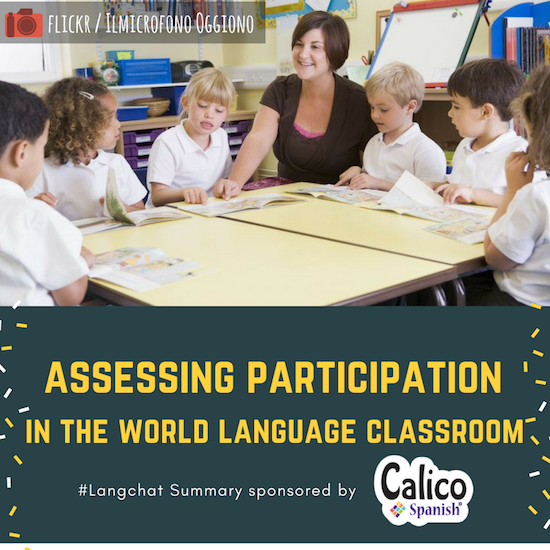Assessing Participation in the World Language Classroom
Our topic for the final #langchat discussion of June centered on how to assess student participation in the world language classroom. We had a thought-provoking chat Thursday night at 8 p.m. EST. Thanks to all our dedicated participants, who shared some great thoughts on the matter, and thanks especially to Erica Fischer (@CalicoTeach) and Sara-Elizabeth Cottrell (@SECottrell) for moderating the chat. If you missed the chat due to summer activities or vacation, you can read the entire archive here.
Participants shared many ideas on how to assess, define and improve student participation in the classroom. Teachers first discussed their definitions of what exactly participation is — does a student need to volunteer in order to be considered participating?
Opinions vary, and while most teachers maintained that this is the most important consideration, it’s clear that there are other accepted methods of participation as well. Personality can play a part in a student’s participation, and shy students might not like to volunteer as often as their more outgoing peers, although they may be following class just as attentively (@klafrench).
– Follow the blog on Bloglovin –
 Assessing Participation
Assessing Participation
Assessing participation is not easy. Some teachers track the number of times a student volunteers or participates in class, but it can be difficult to conduct class and simultaneously evaluate participation (@CalicoTeach). Taking time to track each student’s comments can slow down the pace of the class.
One method for assessing participation is the creation of a rubric. Here is an example of a rubric by Bill Heller for an intermediate level class: http://tinyurl.com/44megen (@ckendall). Such a rubric could be filled out by the student or the teacher, graded or not graded.
The linked rubric contains a focus on grammar, but @ckendall uses a participation rubric that instead focuses on the modes, standards and work habits of students. Rubrics like these are good to help students understand what habits are beneficial to their language learning efforts. @CalicoTeach
Some teachers have completely eliminated participation as a grade from their classes because it can be difficult to accurately measure — assessment is often based too much on perception rather than measurable criteria. @SECottrell
– Like Calico Spanish on Facebook –
Encouraging Participation in the Classroom
Without a grade for motivation, however, how do you encourage students to participate? In large classes it’s difficult to give everyone a chance, but there are methods that you can use to provide more opportunities for speaking. Teachers had several successful ideas to share.
One of our moderators, Sara-Elizabeth Cottrell (@SECottrell), did her thesis on the effect of culture on participation in the ESL classroom. After poring over hours of videos of ESL classes and analyzing which groups volunteered, interrupted and spoke more in the classroom, she found that culture and personality have a lot to do with how students participate in class. She also found that the smaller the group, the more likely the shy students were to speak up.
- Several teachers agreed with this thought, and cautioned that care should be taken to keep groups balanced and put students of similar learning styles, cultures and personalities together.
- An idea to assess participation in group work is to put sticky notes on students’ desks. As you walk around, give them a check if they are on task (@klafrench). A certain number of checks could be a goal — or requirement — of the exercise.
One participant tried cutting out students’ participation grades but noticed a difference in participation after doing so. Rather than using grades as a motivator, however, @alenord now has a specific number of bonus points that students can earn from participation and apply to major grades such as tests. Students can earn points by volunteering or taking an active role in pair or group work, which you can track on the seating chart.
– Follow Calico Spanish on Twitter –
Simply calling names from the roll sheet to assess quiet students is effective, but you can make it a little more interesting by making a game of it. Try an idea like the “popsicle sticks of fate,” where students’ names are on popsicle sticks that are then randomly drawn (@klafrench). Another idea is “voluntarios o victimas” (or your target language equivalent), where when no student volunteers, the teacher picks a “victima” (@ckendall).
- For the tech-friendly teacher, Smart Seat is an interesting app that can promote equitable participation in class by randomly selecting students for participation. It also allows you to create seating charts and easily track attendance. @lee_bruner
For young learners, try giving students marks (or stickers) with different colors for volunteering or answering questions correctly. @SECottrell
To assess your own habits, try having a student or teacher’s aide mark a roster whenever you call on a student or select a volunteer. @SECottrell
Also, check out this PowerPoint on participation and its connection to student motivation from Leeds University: http://bit.ly/iIPbkK. @CalicoTeach
This week’s chat was a short one, but participants shared many good ideas that we hope will prove beneficial to you in your efforts in the classroom. This was the last #langchat before breaking for July, and we will be back on August 4th to renew our discussions and sharing of ideas. Feel free to continue to share resources and ideas through the #langchat hashtag, however, and we’ll see you in August!
Have a great summer!
– Follow us on Instagram too! –






2 Comments
Thanks for another terrific summary, Chris!
Hello,
Do you have a link to the participation rubric mentioned above that “focuses on the modes, standards and work habits of students”? If you could help me locate that, I would greatly appreciate it. Thanks.